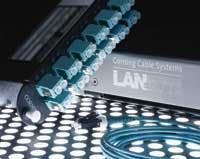Late last summer, Corning Cable Systems (www.corning.com/cablesystems) introduced LANscape Pretium Solutions, a tip-to-tip system for local area networks (LANs) as well as data centers. The system combines innovative products-including fiber-optic cables, connectors, hardware, test equipment, and splice equipment-with technical support and engineering services. Building upon the company's LANscape Solutions brand, the company says Pretium was designed with two characteristics in mind: high performance and ease of use.
The ease-of-use attributes ease the deployment process for installers, saving installation time and thereby reducing the overall cost of deployment. The enhanced-performance attributes allow customers to meet the demands of emerging 10-Gigabit systems.
The system includes the following components:
• Optical cable containing high-bandwidth laser-optimized multimode fiber with reduced cable attenuation of 3.0 dB/km, enabling 10-Gigabit operation up to 550 meters.
• A family of gel-free optical cables, making cable installation and termination quicker and easier.
• UniCam SC and LC ceramic connectors with a 0.2-dB average and 0.5-dB maximum insertion loss, allowing more connectors in the channel or a longer channel.
• The 12-fiber UniCam MTP connector, a high-density field-installable connector for data centers or LANs using ribbon cables. It terminates 12 fibers in less than four minutes.
• Pretium Rack-mountable Connector Housings, with increased jumper cable capacity and a built-in jumper manager.
• New reusable Plug & Play Systems pulling grip, offering better individual connector protection and easier entry than previous-generation grips.
• MTP connector polishing process, which results in improved endface geometry and an insertion loss of 0.75 dB for Plug & Play System termination modules.
• The Windows-based OptiSplice Premier iLID Fusion Splicer, which the company describes as a feature-rich high-performance, user-friendly fusion splicer.
• Fiber Optic Backbone Model, which allows the user to design a complete optical-fiber building or campus backbone in minutes instead of hours.
• Award-winning One Call Gets All customer service.
The online optical-fiber backbone model lets users calculate the kind and amount of optical-fiber cabling they will need to connect their single-building or campus network. The model is available for use free of charge from Corning Cable Systems. It lets users set up their backbones' physical architecture (distributed or collapsed/centralized) and logical architectures (point-to-point, point-to-multipoint, mesh), in addition to length, loss-budget, and all-important cost calculations.
Pretium is a tip-to-tip optical-fiber system that its manufacturer designed specifically for high performance and ease of use.
Users must obtain an access code from a Corning Cable Systems engineer, then can use the code to register on the model site. The company emphasizes that a representative will contact site users only upon request. Once registering for access, users have exclusive access to their individual model site. All designs are considered the user's proprietary property; Corning Cable Systems may reference the model to determine overall market trends.
In addition to the model's calculation functions, it has the ability to generate a number of reports. For example, a topology comparison report shows a cabled-fiber-count comparison by topology and fiber type. That report can be expanded to show how fiber counts are determined for each topology.
A function called the network analyzer evaluates costs based on the cable and electronics costs that the user inputs. The tool also lets the user compare link-loss budgets for 1- and 10-Gigabit Ethernet applications and estimate bandwidth needs to determine the number of uplink reports required.
An optical-fiber hardware generator produces a sample bill of materials for terminating the cable using the company's products.
-Patrick McLaughlin
